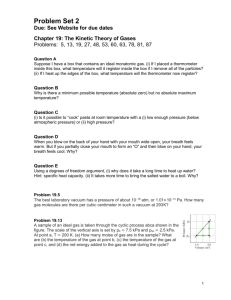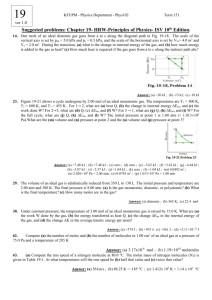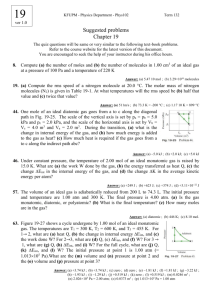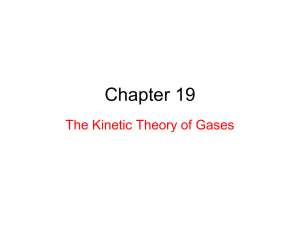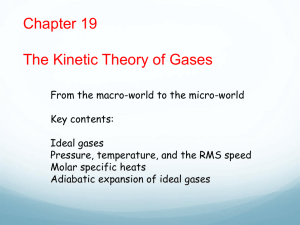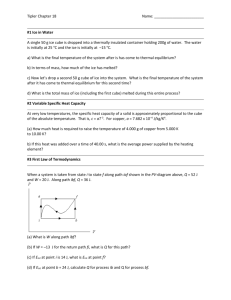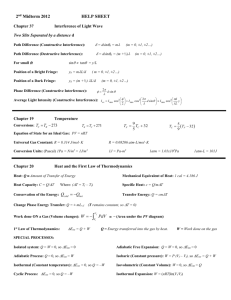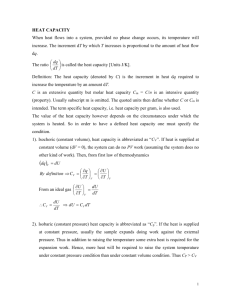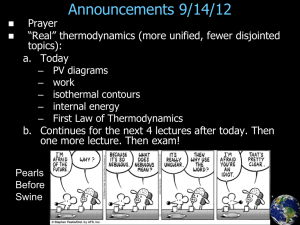Lab. 12 - Determine the value of air
advertisement
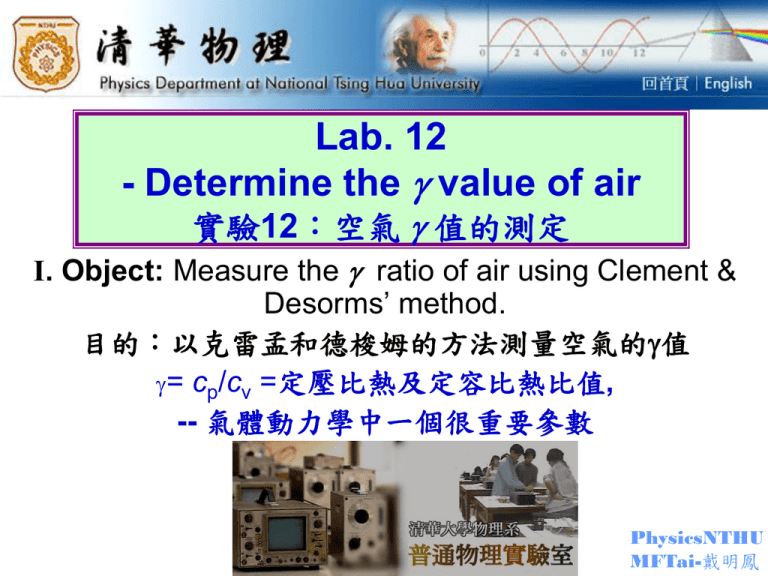
Lab. 12 - Determine the value of air 實驗12:空氣 值的測定 I. Object: Measure the ratio of air using Clement & Desorms’ method. 目的:以克雷孟和德梭姆的方法測量空氣的值 = cp/cv =定壓比熱及定容比熱比值, -- 氣體動力學中一個很重要參數 PhysicsNTHU MFTai-戴明鳳 Adiabatic process (絕熱過程) Broilge Law: at constant T,an ideal gas with the fixed particles obeys PV = nRT =constant. But real gas isn’t a good heat conductor, it need time to reach a new thermal equilibrium. As P and V change too rapidly, e.g., the propagation of sound, the energies between the parts of gas can not exchange with each other at once. So it is impossible for the isothermal process (等溫過程), the realize reaction shall be an adiabatic process. Adiabatic process: 1. If gas is compressed (expanded), all work done by the surrounding becomes (dissipate) the internal energy of gas, thus the P and T of gas will simultaneously increase (decrease). 2. The slope of p(V) curve in adiabatic process must steeper than in the isothermal process. PhysicsNTHU MFTai-戴明鳳 Principle (原理) 熱力學第一定律(能量守恆):系統能量 U 之微分 dU (1st thermodynamical law: energy conservation law) 吸/放熱+作正功(endothermic/exothermic reaction + do positive work): dU = dQ + dW 吸/放熱+作負功(endothermic/exothermic reaction + do negative work): dU = dQ – pdV 摩爾定容比熱(molar heat capacity at constant volume) 摩爾定壓比熱 (molar heat capacity at constant pressure) 1 dQ 1 dU cV n dT V n dT V 1 dQ U V cp ( ) p ( ) p p( ) p n dT T T 空氣在室溫(T ~ 300 K)可視為接近理想氣體 (Air at 300 K can be as idea gas) pV = NkT , pV = nRT N = 粒子數 (Particle number) k = 1.38 x 10-23 J/K = 波茲曼常數(Boltzman constant) n N/NA = 粒子摩爾數(Molar no.) NA = 6.02 x 1023 /mol = 亞佛加德常數(Advogadro constant) PhysicsNTHU R kNA = 8.31 J/mol-K = 氣體常數 (Gas constant) MFTai-戴明鳳 Derive the value of idea gas Ideal gases pV = nRT pdV + Vdp = nRdT Constant Pressure dp = 0 (定壓時) dQ = dU + pdV = dU + nRdT 1 dQ 1 dU 1 d ( PV ) p cp n dT p n dT p n dT cP = cv + R 1 dQ 1 d (nRT ) p 1 dQ R n dT p n dT n dT p = cp/cv = (cV +R)/cv c p cv R 能量均分(Equipartition of Energy): kT/2 per degree of freedom 空氣主要為雙原子分子N2 : 78%, O2 : 21%,在室溫(T ~ 300 K) 有3個自由度的平移,2個自由度的轉動,但不會振動。 故每一分子共有5自由度,每自由度貢獻 kT/2 能量。 總能量Total = U ~ 5nRT/2 定容比熱: cv ~ 5 R/ 2 定壓比熱: cp = cv + R ~ 7 R/ 2 PhysicsNTHU 定壓比熱及定容比熱比值: cp/cV ~ 7/5 MFTai-戴明鳳 (19 – 11) Internal Energy of an ideal Gas 理想氣體的內能 Internal energy of an ideal gas 3nRT Eint 2 Consider a monatomic gas such as He, Ar, or Kr. In this case the internal energy Eint of the gas is the sum of the translational kinetic energies of the contituent atoms The average translational kinetic energy of a single atom is given by the equation: 3kT K avg A gas sample of n moles contains N nN A atoms. The internal 2 nN A 3kT 3nRT energy of the gas Eint NK avg 2 2 The equation above it expressing the following important result: The internal energy Eint of an ideal gas is a function of gas temperature only; it does not depend on any other parameter. PhysicsNTHU MFTai-戴明鳳 Molar specific heat CV at constant volume Consider n moles of an ideal gas at pressure p and temperature T . The gas volume is fixed at V . These parameters define the initial state of the gas. A small heat quantity Q is added from the reservoir that changes the temperature to T T and the pressure to p p and brings the system to its final state. The heat Q nCV T The constant Eint nCV T CV 3R 2 CV is called the molar specific heat at constant volume. From the first law of thermodynamics we have: Q Eint W . W pV 0 Thus Q Eint nCV T CV = Eint nT 3nRT 3nRT 3R Eint CV 2 2 2 We can write the internal energy of the gas in the following form: Eint nCV T Eint Eint nCV T PhysicsNTHU MFTai-戴明鳳 Molar specific heat C p at constant pressure We assume that we add a heat amount Q to the gas and change its temperature from T to T T and its volume from V to V V while keeping the pressure constant at p The heat Q nC p T The constant C p is called molar specific heat at constant pressure. The first law of thermodynamics gives: Q W Eint nC p T pV nCV T Using the law of ideal gases pV nRT we get: pV nRT nC p T nRT nC p T Thus: C p CV R C p CV R PhysicsNTHU MFTai-戴明鳳 Degrees of freedom and molar specific heats f =3 f =5 3R agrees with the experimental 2 data of monatomic gases but fails for diatomic and polyatomic gases. The reason is that for diatomic and polyatomic molecules The equation CV have more complex motions that the simple translational motion we assummed for monatomic gases. The formar can have rotational motion about 2 orthogonal axes and also oscillatory motion about f =6 the equilibrium position. To account for these effects Maxwell introduced the theorem of equipartition of energy that states: Every type of molecule has f degrees of freedom which defined as independent ways in which the molecule can store energy. Each degree of freedom has an average energy kT / 2 per molecule or RT / 2 per mole. fR 2 f is equal to 3 for monatomic gases, f 5 for diatomic gases, PhysicsNTHU and f 6 for polyatomic gases. The corresponding molar specific heat is: CV fR CV 2 MFTai-戴明鳳 Cv = 3/2R = 12.5 J/mol.K Cp = 5/2R = 20.8 J/mol.K CP 5R / 2 1.67 CV 3R / 2 Theoretical values of CV, CP, and are in excellent agreement for monatomic gases. PhysicsNTHU MFTai-戴明鳳 Molar Specific Heat for an Ideal gas Several processes can change the temperature of an ideal gas. Since T is the same for each process, Eint is also the same. The heat is different for the different paths. The heat associated with a particular change in temperature is not unique. Specific heats are frequently defined at two processes: – Constant-pressure specific heats cp – Constant-volume specific heats cv Using the number of moles, n, defines molar specific heats for these processes. PhysicsNTHU MFTai-戴明鳳 pV i i p f Vf Adiabatic expansion of an ideal gas Consider the ideal gas in fig.a. The container is well insulated. When the gas expands no heat is transferred to or from the gas. This process is called adiabatic. Such a process is indicated on the p - V diagram of fig.b. by the red line. The gas starts at an initial pressure pi and TV i i 1 initial volume Vi . The corresponding final parameters Tf V f 1 are p and V . The process is described by the equation: f f piVi p f V f Here the constant Cp CV Using the ideal gas law we can get the equation: TV i i 1 Tf V f 1 1 V T f Ti i 1 Vf If V f Vi we have adiabatic expansion and T f Ti If V f Vi we have adiabatic compression and T f Ti PhysicsNTHU MFTai-戴明鳳 Adiabatic expansion dQ = 0 (絕熱膨脹) For an ideal gas with n =1 pV RT pdV Vdp RdT dQ 0 Cv dU Cv dT ( pdV Vdp) R Cv Cv R Vdp pdV R R dp dV p V ln p ln V A pV i i p f Vf TV i i 1 Tf V f 1 PV A ' Here both A and A’ are constant values. The slope of p(V) curve in adiabatic process must steeper than in the isothermal process. One can determine the value from the adiabatic process. PhysicsNTHU MFTai-戴明鳳 Free expansion In a free expansion a gas of initial volume Vi and initial pressure pi is allowed to expand in an empty container so that the final volume is V f and the final pressure p f Ti T f piVi p f V f In a free expansion Q 0 because the gas container is insulated. Furthermore since the expansion takes place in vacuum the net work W 0 The first low of thermodynamics predicts that Eint 0 Since the gas is assumed to be ideal there is no change in temperature Ti T f Using the law of ideal gases we get the following equation which connects the initial with the final state of the gas: piVi p f V f (19 – 16) PhysicsNTHU MFTai-戴明鳳 Block Diagram of ClementDesorms’ Experiment 1 2 P1 T1 = To V1 P2 = Po T2 V2 1 1 (1) PV P2V2 3 P3 T3 = To V3 = V2 (2) P1V1 = P3V2 p0 B p A h (1) Adiabatic expansion (2) Isothermal expansion PhysicsNTHU MFTai-戴明鳳 Clement-Desorms’ Configuration 克雷孟-德梭姆 實驗裝置 球型玻璃瓶(spherical glassware) 銅蓋(Cupper Tip, 可沿瓶口水平方向滑動 而移開或滑入原位) 橡皮管 (rubber tube) 玻璃氣閥 (glass valve) 打氣球 (gas charging ball) U-型軟管(U-shape soft tube, 內裝測 氣體壓力的液體) PhysicsNTHU MFTai-戴明鳳 Clement-Desorms’ Experiment Configuration 克雷孟-德梭姆方法的實驗裝置 Initial condition of system: at room temperature, T0 ~ 300 K and under ambient atmosphere, p0 = 1 atm (系統起始條件:室溫時,一大氣壓力的靜態環境下) (1) 關A銅蓋閥,開B玻璃氣閥 用打氣球將空氣打入球型玻璃容器中, 使系統壓力增加至p1, 關玻璃氣閥。 等幾分鐘, 讓系統與外界熱平衡, 以U型開口壓力計測壓力差高度h1, 可得 p1 = p0 + h1d·g d: 壓力計液體比重, g: 重力加速度 T1 = T0 PhysicsNTHU MFTai-戴明鳳 (2) 開B閥, 讓氣體急速絕熱膨脹排出, 使容器內外壓力相同, 關B閥. p2 = p0 p1V1 = p2V2 (絕熱膨脹, 外界熱量來不及進入) T2 < T1 = T0 (膨脹後溫度降低) (3) 等幾分鐘, 讓外界熱量流入使達熱平衡 p0 T3 = T0 (熱平衡) 測量壓力差高度h3,得 p3 = p0 + h3dg B A (A) p1V1 = n1RT0 (T1 = T0) h p = (n1/n3)p3V3 (T0 = T3) ~ p3V3 (n1 ~ n3) (B) p1V1 = p0V2 (p2 = p0) ~ p0V3 (V2 ~ V3, 體積由大玻璃瓶控制) (A)/(B) p1-1 = p3/p0 (p1, p3代入) PhysicsNTHU or = h3/(h1 - h3) (與理論值 = 7/5 = 1.4 比較) MFTai-戴明鳳 Value derived in Classical Mechanics 1 1 p V p2V2 h1 , h3 10 - 20 cm and p 1 g/cm 3 p1V1 p3V2 1 1 p p0 76 cmHg h3 g 2 h1 g 2 ( ) 1, ( ) 1. p0 p0 p3 po p1 p0 h1 g p3 p0 h3 g ( p0 h1 g ) 1 1 ( p0 h3 g ) p0 h3 g h1 g 1 (1 ) (1 ) p0 p0 h3 g h1 g 1 ( 1) 1 p0 p0 h2 h1 h3 PhysicsNTHU MFTai-戴明鳳 Molar Specific Heat Specific heats are frequently defined at two processes: – Constant-pressure specific heats cp – Constant-volume specific heats cv Using the number of moles, n, defines molar specific heats for these processes. Molar specific heats: – Q = nCvT for constant volume processes – Q = nCpT for constant pressure processes Q (in a constant pressure process) must account for both the increase in internal energy and the transfer of energy out of the system by work. Q(constant P) > Q(constant V) for given values of n and T PhysicsNTHU MFTai-戴明鳳 Ideal Monatomic Gas - contains only one atom per molecule When energy is added to a monatomic gas in a container with a fixed volume, all of the energy goes into increasing the translational kinetic energy and temperature of gas. – There is no other way to store energy in such a gas. Eint = 3/2nRT, in general, the internal energy of an ideal gas is a function of T only. The exact relationship depends on the type of gas At constant volume, Q = Eint = nCvT, applies to all ideal gases, not just monatomic ones. PhysicsNTHU MFTai-戴明鳳 Specific Heat of Monatomic Gases At constant volume, Q = Eint = nCvT applies to all ideal gases, not just monatomic ones. Cv = 3/2R = 12.5 J/mol.K – Be in good agreement with experimental results for monatomic gases. In a constant pressure process, Eint = Q + W Cp – Cv = R Cp = 5/2R = 20.8 J/mol.K – This also applies to any ideal gas Define a Ratio of Molar Specific Heats CP 5R / 2 1.67 CV 3R / 2 Theoretical values of CV, CP, and are in excellent PhysicsNTHU agreement for monatomic gases or any ideal gas. MFTai-戴明鳳 PhysicsNTHU MFTai-戴明鳳 Adiabatic Process for an Ideal Gas At any time during the process, PV = nRT is valid – None of the variables alone are constant – Combinations of the variables may be constant The pressure and volume of an ideal gas at any time during an adiabatic process are related by PV = constant All three variables in the ideal gas law (P, V, T) can change during an adiabatic process PhysicsNTHU MFTai-戴明鳳 例題 柴油引擎汽缸 Adiabatic compression process Vi 800 Pf Pi 1.00 37.6 atm 60.0 Vf PiVi PfVf (for ideal gas) Ti Tf 1.40 PhysicsNTHU MFTai-戴明鳳 Equipartition of Energy for Complex Molecules Other contributions to internal energy must be taken into account: 1. Translational motion of the center of mass: 3 degrees of freedom 2. Rotational motion about the various axes: 2 degrees of freedom for x and z axes To neglect the rotation around the y axis since it is negligible compared to the x and z axes. Eint = 5/2nRT CV = 5/2R = 20.8 J/mol.K Cp = 7/2R = 29.1 J/mol.K predicts that = 7/5 = 1.40 PhysicsNTHU MFTai-戴明鳳 Equipartition of Energy The molecule can also vibrate There is kinetic energy and potential energy associated with the vibrations This adds two more degrees of freedom Eint = 7/2nRT, Cv = 7/2R = 29.1 J/mol.K = 1.29 This doesn’t agree well with experimental results. A wide range of temperature needs to be included. For molecules with more than two atoms, the vibrations are more complex. The number of degrees of freedom is larger The more degrees of freedom available to a molecule, the more “ways” there are to store energy, and the higher molar PhysicsNTHU specific heat. MFTai-戴明鳳 Agreement with Experiment -Molar specific heat of a diatomic gas (acts like a monatomic gas) is a function of T. at high T CV = 7/2R at about room T Cv = 5/2R at low T Cv = 3/2R PhysicsNTHU MFTai-戴明鳳 Quantization of Energy Classical mechanics is not sufficient to explain the results of the various molar specific heats, we must use some quantum mechanics. The rotational and vibrational energies of a molecule are quantized The energy level diagram of the The vibrational states are separated by larger energy gaps than are rotational states. 1. At low T, the energy gained during collisions is generally not enough to raise it to the first excited state of either rotation or vibration. Even though rotation and vibration are classically allowed, they do not occur. rotational and vibrational states of a diatomic molecule. PhysicsNTHU MFTai-戴明鳳 DVD: 自然界的引擎 (Engine of Nature)(MU46) 熱力學第一定律: 能量守恆定律 dU = dQ – dW (系統增加之熱能 = 吸收熱量 – 對外作功(work)) dU = TdS – pdV (S = dQ/T 亂度(entropy)) 熱機(熱引擎)(heat engine) 高溫(Tinput)吸熱 Qi, Si = Qi/Ti (Ti = constant) 低溫(Toutput)放熱 Qo, So = Qo/To 對外作功 W = Qi – Q0 效率(efficiency) e W/Qi = 1 – Qo/Qi 卡諾循環(Carnot cycle)/卡諾熱機(Carnot engine) 1.高溫等溫膨脹(isothermal expansion) Ti = constant, 吸熱Qi 2.絕熱膨脹(adiabatic expansion) dQ = 0 (絕熱), Ti To (降溫) 3.低溫等溫壓縮(isothermal compression), To = constant, 放熱Q0 4.絕熱壓縮(adiabatioc compressiion) dQ = 0, To Ti (昇溫) PhysicsNTHU = W/Qi = 1 – To/Ti (Si = So, 理想熱機/ideal heat engine) MFTai-戴明鳳
